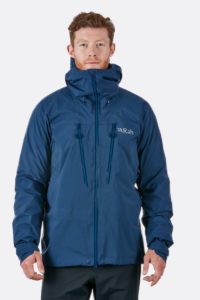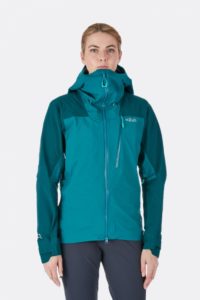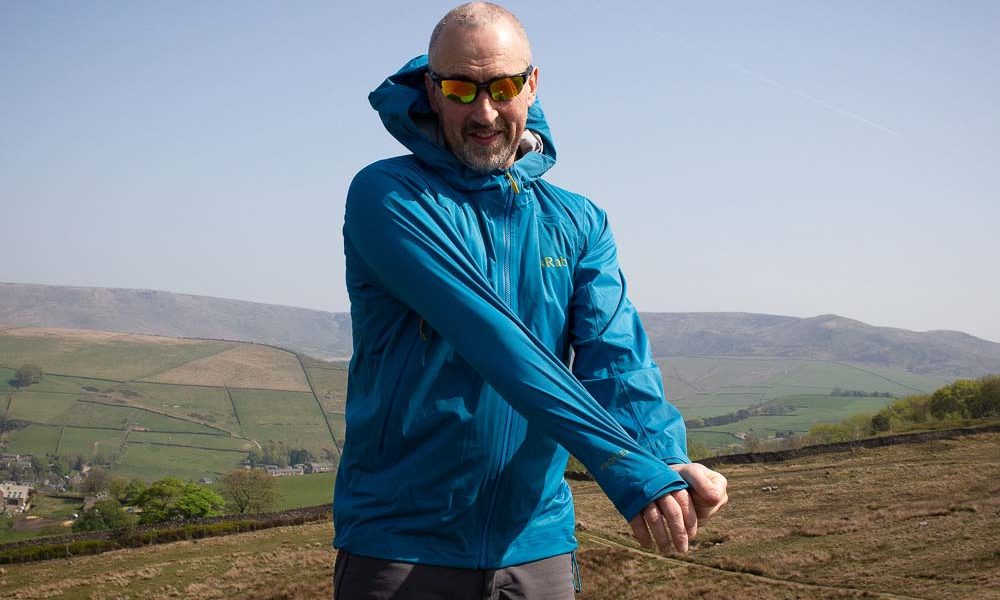I struggle with Mammut clothing. Not because it’s not nicely made or constructed from top-notch materials or thoughtfully designed – it is all those things – but because no matter how hard I try, I cannot be an elongated, greyhound lean, Swiss mountaineer. And that in turn means that Mammut’s stock cut, which seems to be modelled on someone who is both five or six inches taller than me and narrower in the hips and shoulders, simply doesn’t work for me. In practice that means the Mammut Crater waterproof jacket I’ve just started using, finishes somewhere below crotch level and wraps around my hips like a giant Tubigrip bandage. It’s a good jacket no doubt, but it’s not a good jacket for me.
All of which got me thinking about outdoor clothing fit and how it’s something of an afterthought that gets dragged in after fabric technologies, design features and value. But it’s actually a really crucial part of how well clothing works and the bottom line is that you can have all the fancy fabrics and cunning design features in the world, but if the garment fits badly, it won’t work as well as it could and should.

Rab Latok: Lots of volume and very long sleeves
How do different brands fit?
In a word, ‘differently’. It all depends on how the brand sees its typical customer. Mammut aims for a tall, sleek fit, but other brands have a different model. Arc’teryx tends to be slim and fitted in the mid-section, but really big up top, so if you have that broad-shouldered lumberjack/built climber physique, the Canadian brand is worth a look. Rab’s latest shells have plenty of space all round, but most notably have the longest sleeves on the market, which is worth knowing if you have gibbon-like climber’s arms.
And then there’s Patagonia, which can tend towards the boxy. I once read an interview with Chouinard where he said the brand has grown older with its customers and so the cut has become more relaxed over time. Of course some brands have more than one fit option: Mountain Equipment ran a three-year fit project with a team of Swiss consultants, which resulted in two hardshell fits. The first is a sleek, athletic alpine cut used in the likes of the Lhotse and Tupilak shells that manages the neat trick of fitting closely without restricting movement. The second is a more traditional ‘mountain’ cut that gives more leeway for extra layers natural or otherwise. Similarly the Berghaus Extrem and Mtn.Haus kit is super sleekly proportioned to fit, well, let’s be honest, Leo Houlding, but the brand’s more walking-orientated kit has a more relaxed fit to suit a more relaxed consumer.
It’s a bit like trying boots. You want the brand that feels right for your body.
Gearhead takeaway: Try different brands until you find one that suits your body shape rather than Leo Houlding or a giraffe.
Why fit matters
It’s not just about vanity and looking cool propping up the bar in the Clachaig with icicles dripping from your nostril hairs and onto your sleekly-cut shell, fit is also a vital part of functionality. Why? First, a restrictive fit can actually impair movement, particularly if you’re climbing or scrambling, but even if you’re walking. A jacket with an over-long, over-tight fit around the hips can restrict you on high step-ups, but will also tend to rise up and bunch around your waist in the worst case scenario. Narrow shoulders will, not surprisingly, be uncomfortable and restrictive and sleeves that pull up when you reach up or out in front of you when climbing will expose your wrists to cold and damp. Equally you don’t want the hem of your jacket pulling up when you reach for a distant hold.
And then there are hoods. A good hood will, when properly adjusted, move with your head from side to side, but also not press painfully on your chin when cinched up and will have enough fabric in the neck that you can look up or down freely. If it’s a helmet hood, that’s doubly important if you want to be able to see where you’re going easily when climbing. We all have different length necks and variable chins, so don’t take hood fit on trust, try it first.
The same’s true with legwear. Badly-articulated knees will hold you back on steps, a crotch without enough movement will stop you bridging properly and hey, on steep terrain, flappy lower legs will stop you seeing what you’re standing on – always disconcerting – and in winter makes for a crampon-snagging hazard.
Gearhead takeaway: When buying an outdoor shell or legwear, throw some climbing shapes to make sure you’re not restricted. Try the hood on properly with and without a helmet if you intend to use one. Step up, reach out and up, look everywhere and if the shell restricts you, try something else.

Helmet hoods need trying with your own helmet
The layering dilemma
There’s more to it than just being restricted though. How effectively your clothes work to protect and keep you comfortable is also partly down to fit. The classic line about loose-fitting shell jackets is that there’s enough space to fit a decent insulation layer underneath. Which is fine if you want to layer over an expedition weight down jacket, but modern mid-layer are often stretchy and close fitting for better insulating efficiency. Wear a baggy, flappy jacket over them and you’re actually creating internal air currents that can move warmed air around and away from the body.
Conversely an overly tight shell layer can compress some types of insulation so it traps less air and is less warm – notably high-loft, ‘fluffy’ fleece, down or synthetic puffy-type stuff. The same goes for legwear, if adding baselayer leggings under your softshell kecks means you can’t bend your leg properly, then they’re arguably a tad tight. One partial solution is to add a waist cord to give some adjustment in the mid-section. Loosen off for bulky mid-layers, cinch it down for a closer fit.
Gearhead takeaway: Think about your mid-layer choice realistically and check there’s enough space under shell clothing to fit it in without making things tight and restrictive.
Stretch and cunning cuts
Cutting things both to fit well and also give unrestricted movement is an art form and comes down to pattern cutting – without getting the design of separate panels right, you might find the only way to get the movement you need is to incorporate lots of excess fabric. Check out weirds 1970s-style bat-wing designs and jacket with wads of loose fabric around the rear of the shoulders. That means excess weight and bulk, unnecessary flappiness and, in all honesty, a look that often just seems ‘wrong’.
Another solution is the use of stretch fabric and panels to improve fit. I say ‘fit’ rather than mobility because my experience is that they really don’t do that. If you put a stretch panel behind the shoulder, for example, the cuffs will tend to pull up over your wrists rather than actually extend. What they are great for is giving a close fit, but with the capacity to adapt to bulkier layers and bulkier users too.
Gearhead takeaway: I’m a big fan of Mountain Equipment’s hardshell jackets. For me they do a great job of combining a neat, non-flappy, 3-dimensional cut with excellent mobility, but there are other options out there that may fit your body shape better.

Women’s jackets need a substantially different fit from men’s
And the aesthetics…
I’m not going to labour this, but well-fitted, well-fitting clothing just looks better. Don’t get me wrong, I’ll take functionality over fashion every time, but given the choice between, say, a neatly cut softshell mountain, erm, pant that also does the job and one that’s flappy and ‘wrong’ though functionally okay and I’ll take the one that fits better and looks neater. Thing is though, the one that fits better generally works better too.
Gearhead takeaway: Nowt wrong with looking pro, particularly when pro looks also mean pro functionality. Vain, moi?
The big picture
Clothing fit makes a real difference to clothing function, so make a point of checking out the basics when you’re buying. And remember, what might might seem like a small niggle in the shop – a hood that’s slightly tight on your chin maybe or a hem that hints at riding up when you’re walking – can become a little more wearing after a long day on the hill. And the Mammut guy? I think I once almost climbed a mountain with him in the Andes – Swiss, greyhound lean, six foot and a bit more and very, very quick uphill. I don’t actually remember what he was wearing, but it really wouldn’t surprise me if it had a woolly mammoth motif on the sleeve.
Bottom line: Kit that fits properly doesn’t just look more pro – if that bothers you – but works better as insulation and ensures that your movements aren’t restricted. And because every brand fits different shapes, it’s worth making the effort to find one that works for you.






